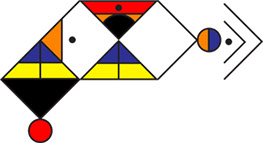
An abugida – sometimes also called alphasyllabary, neosyllabary, or pseudo-alphabet – is a segmental writing system in which consonant–vowel sequences are written as units; each unit is based on a consonant letter, and vowel notation is secondary, like a diacritical mark. This contrasts with a full alphabet, in which vowels have status equal to consonants, and with an abjad, in which vowel marking is absent, partial, or optional – in less formal contexts, all three types of the script may be termed "alphabets". The terms also contrast them with a syllabary, in which a single symbol denotes the combination of one consonant and one vowel.
Katakana is a Japanese syllabary, one component of the Japanese writing system along with hiragana, kanji and in some cases the Latin script.
Kana are syllabaries used to write Japanese phonological units, morae. Such syllabaries include (1) the original kana, or magana, which were Chinese characters (kanji) used phonetically to transcribe Japanese, the most prominent magana system being man'yōgana (万葉仮名); the two descendants of man'yōgana, (2) hiragana, and (3) katakana. There are also hentaigana, which are historical variants of the now-standard hiragana. In current usage, 'kana' can simply mean hiragana and katakana.
In the linguistic study of written languages, a syllabary is a set of written symbols that represent the syllables or moras which make up words.
A syllable is a unit of organization for a sequence of speech sounds, typically made up of a syllable nucleus with optional initial and final margins. Syllables are often considered the phonological "building blocks" of words. They can influence the rhythm of a language, its prosody, its poetic metre and its stress patterns. Speech can usually be divided up into a whole number of syllables: for example, the word ignite is made of two syllables: ig and nite.

Cherokee or Tsalagi is an endangered-to-moribund Iroquoian language and the native language of the Cherokee people. Ethnologue states that there were 1,520 Cherokee speakers out of 376,000 Cherokee in 2018, while a tally by the three Cherokee tribes in 2019 recorded ~2,100 speakers. The number of speakers is in decline. The Tahlequah Daily Press reported in 2019 that most speakers are elderly, about eight fluent speakers die each month, and that only 5 people under the age of 50 are fluent. The dialect of Cherokee in Oklahoma is "definitely endangered", and the one in North Carolina is "severely endangered" according to UNESCO. The Lower dialect, formerly spoken on the South Carolina–Georgia border, has been extinct since about 1900. The dire situation regarding the future of the two remaining dialects prompted the Tri-Council of Cherokee tribes to declare a state of emergency in June 2019, with a call to enhance revitalization efforts.

The Cherokee syllabary is a syllabary invented by Sequoyah in the late 1810s and early 1820s to write the Cherokee language. His creation of the syllabary is particularly noteworthy as he was illiterate until its creation. He first experimented with logograms, but his system later developed into the syllabary. In his system, each symbol represents a syllable rather than a single phoneme; the 85 characters provide a suitable method for writing Cherokee. Although some symbols resemble Latin, Greek, Cyrillic, and Glagolitic letters, they are not used to represent the same sounds.
English phonology is the system of speech sounds used in spoken English. Like many other languages, English has wide variation in pronunciation, both historically and from dialect to dialect. In general, however, the regional dialects of English share a largely similar phonological system. Among other things, most dialects have vowel reduction in unstressed syllables and a complex set of phonological features that distinguish fortis and lenis consonants.
In linguistics, vowel length is the perceived length of a vowel sound: the corresponding physical measurement is duration. In some languages vowel length is an important phonemic factor, meaning vowel length can change the meaning of the word, for example in Arabic, Estonian, Finnish, Fijian, Japanese, Kannada, Kyrgyz, Latin, Malayalam, Old English, Scottish Gaelic, Tamil and Vietnamese.

Canadian syllabic writing, or simply syllabics, is a family of writing systems used in a number of Indigenous Canadian languages of the Algonquian, Inuit, and (formerly) Athabaskan language families. These languages had no formal writing system previously. They are valued for their distinctiveness from the Latin script and for the ease with which literacy can be achieved. For instance, by the late 19th century the Cree had achieved what may have been one of the highest rates of literacy in the world.

The Yi scripts are two scripts used to write the Yi languages; Classical Yi, and the later Yi syllabary. The script is historically known in Chinese as Cuan Wen or Wei Shu and various other names (夷字、倮語、倮倮文、畢摩文), among them "tadpole writing" (蝌蚪文).
An inherent vowel is part of an abugida script. It is a vowel sound which is used with each unmarked or basic consonant symbol. For example, if the Latin alphabet used 'i' as an inherent vowel, "Wikipedia" could be rendered as "Wkpeda" [w(I)+k(I)+p+e+d(I)+a].

Eastern Pomo, also known as Clear Lake Pomo, is a nearly extinct Pomoan language spoken around Clear Lake in Lake County, California by one of the Pomo peoples.

Hittite cuneiform is the implementation of cuneiform script used in writing the Hittite language. The surviving corpus of Hittite texts is preserved in cuneiform on clay tablets dating to the 2nd millennium BC.

A semi-syllabary is a writing system that behaves partly as an alphabet and partly as a syllabary. The main group of semi-syllabic writing are the Paleohispanic scripts of ancient Spain, a group of semi-syllabaries that transform redundant plosive consonants of the Phoenician alphabet into syllabograms.

The Khom script is a writing system formerly used in Laos. The term "Khom" is also used to refer to the Ancient Khmer lettering used in Thailand's Buddhist temples to inscribe sacred Buddhist mantras and prayers, but that is an entirely different script.
The Woleai or Caroline Island script, thought to have been a syllabary, was a partially Latin-based script indigenous to Woleai Atoll and nearby islands of Micronesia and used to write the Woleaian language until the mid-20th century. At the time the script was first noticed by Europeans, this part of Micronesia was known as the Caroline Islands, hence the name Caroline Island script.

A writing system comprises a particular set of symbols, called a script, as well as the rules by which the script represents a particular language. Most writing systems can be broadly categorized into alphabets, syllabaries, or logographies. Alphabets use symbols called letters that correspond to spoken phonemes. Abjads generally only have letters for consonants, while pure alphabets have letters for both consonants and vowels. Abugidas use characters that correspond to consonant–vowel pairs. Syllabaries use symbols called syllabograms to represent syllables or moras. Logographies use characters that represent semantic units, such as words or morphemes.
The Bagam or Eghap script is a partially deciphered Cameroonian script of several hundred characters. It was invented by King Pufong of the Bagam (Eghap) people, c. 1900, and used for letters and records, though it was never in wide use. It is reputedly based on the Bamum script, though the numerals show more resemblance to Bamum than the syllabograms do, and it does not appear to be a direct descendant. The only attested example is a paper by Louis Malcolm, a British officer who served in Cameroon in World War I. This was published without the characters in 1921, and the manuscript with characters was deposited in the library of Cambridge University. This was published in full in Tuchscherer (1999).

Ditema tsa Dinoko, also known as ditema tsa Sesotho, is a constructed writing system for the siNtu or Southern Bantu languages. It is also known by its IsiZulu name isiBheqe soHlamvu, and by various other names in different languages. It was developed in the 2010s from antecedent ideographic traditions of the Southern African region. Its visual appearance is inspired by these, including the traditional litema arts style. It was developed between 2014 and 2016 by a group of South African linguists and software programmers with the goal of creating a denser writing system to avoid the slowness in reading caused by the word length and visual homogeneity of Southern Bantu languages written in the Roman alphabet. As of 2023, no proposal has been made to encode the script in Unicode, the text encoding standard designed to support all of the world's major writing systems.











